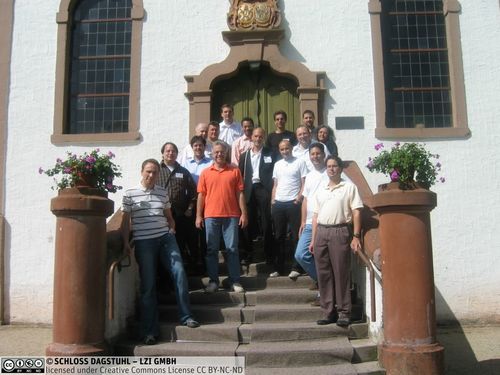Dagstuhl-Seminar 06361
Computing Media and Languages for Space-Oriented Computation
( 03. Sep – 08. Sep, 2006 )
Permalink
Organisatoren
- André DeHon (University of Pennsylvania, US)
- Jean-Louis Giavitto (University of Evry, FR)
- Frédric Gruau (Université Paris Sud, FR)
Kontakt
Traditional models of computation have abstracted out physical locations in space (e.g. the Internet, superscalar processors, unit delay wires, uniform memory delay) and implementations predominantly perform computations in time (i.e. sequentially). Most of our common data structures are spatially agnostic (e.g. arrays). But:
- As scaling continues (both as primitive elements shrink to the atomic scale, and the number of elements composed scales up), computations must be distributed in space and location in space impacts the performance and feasibility of the computation.
- As we couple and embed computing in the physical world (e.g. smart building, reactive surfaces, programmable matter, distributed robotics), position and shape are primary, serving as both the input to computation and a key part of the desired result of the computation.
- As we understand natural computing systems (e.g. cells, ant colonies, system’s biology) location and topology define the computation. Consequently, it is important to make space not an issue to abstract away, but a first-order effect that we optimize. The distinguishing feature of spatial computing then is that computation is performed distributed in space and position and distance metrics matter to the computation.
During the workshop, three thematic areas have been identified: intensive computing where space is used as a mean and as a resource, computation embeded in space where location is important for the problem and space computation where space is fundamental to the problem and is a result of a computation.
With the cheap availability of high capacity spatial computing substrates, an emerging understanding of natural systems, and the possibility of computationally engineered matter, the importance of spatial aspects of computation is growing. These different manifestations of spatial computing have clear intersections where they can share common theory, tools, and insights. A solid mastery of spatial computation will allow us to transform our engineering capabilities, our understanding of the natural world, and ultimately the world in which we live.
This fruitfull event was made possible thanks to the cordial reception and the perfect support of all the Dagsthul staff. The coordinators of the workshop wish particularly thanks Jutka Gasiorowski, Angelika Mueller and Annette Beyer for their patience and constant help. Our acknowledgements also goes to all the participants that have made this first meeting a success.
- Jacob Beal (MIT - Cambridge, US) [dblp]
- Hugues Berry (University of Paris South XI, FR)
- Katherine Compton (University of Wisconsin - Madison, US)
- Daniel Coore (The University of the West Indies - Mona, JM)
- André DeHon (University of Pennsylvania, US) [dblp]
- Peter Dittrich (Universität Jena, DE) [dblp]
- Christine Eisenbeis (University of Paris South XI, FR)
- Jean-Louis Giavitto (University of Evry, FR)
- Seth Copen Goldstein (Carnegie Mellon University - Pittsburgh, US) [dblp]
- Daniel Große (Universität Bremen, DE) [dblp]
- Frédric Gruau (Université Paris Sud, FR)
- Jörn W. Janneck (Xilinx - San José, US)
- Christian Lasarczyk (Kamen, DE)
- Guy Lemieux (University of British Columbia - Vancouver, CA)
- Olivier Michel (University of Evry, FR)
- John Savage (Brown University - Providence, US)
- Antoine Spicher (University of Evry, FR)
Klassifikation
- Architecture
- Programming Languages / Compiler
Schlagworte
- hardware architecture
- computing medium
- space-oriented computation
- nonconventional programming models


